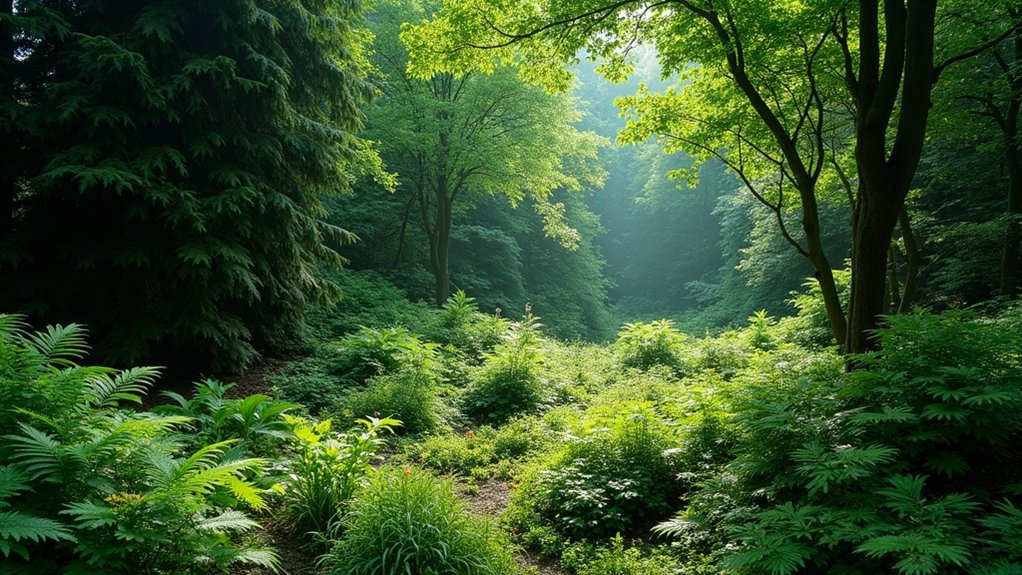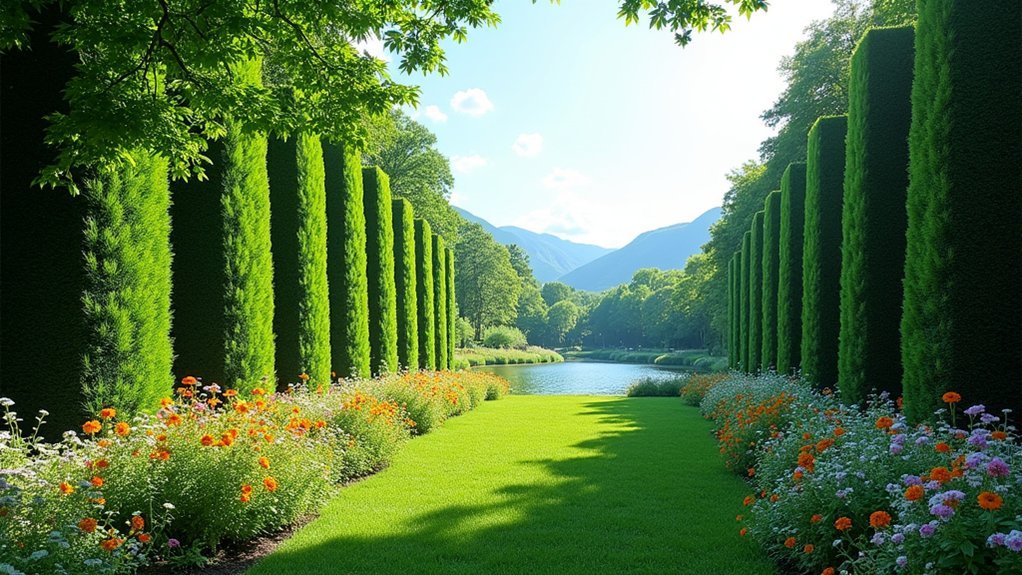For maximum noise reduction, layer your natural sound barriers strategically. Start with tall evergreens closest to the noise source, followed by mid-height shrubs, and low-growing plants in front. Combine vegetation with earth berms for enhanced effectiveness, placing dense plantings at both the top and base. Year-round protection requires evergreens supplemented with deciduous varieties and mulch. The right combination of plant heights, densities, and placements creates a multi-dimensional barrier that tackles various sound frequencies.
Understanding the Science of Sound Barriers in Landscaping

While many homeowners turn to artificial walls and fences for noise control, natural elements can serve as equally effective sound barriers when strategically implemented.
Understanding how sound travels helps you maximize your landscaping’s noise-reducing potential. Sound waves diminish with distance, so placing your barrier near the noise source creates immediate impact.
Dense plantings work by both absorbing and blocking sound waves. Evergreens with thick foliage excel at interrupting higher frequencies, while layered arrangements of varied heights tackle a broader sound spectrum.
For extensive noise reduction, combine soil berms with strategic plantings—the earth’s mass absorbs lower frequencies while vegetation handles higher ones. This multi-dimensional approach creates a natural sound barrier system that’s both functional and aesthetically pleasing, reducing neighborhood noise without sacrificing your landscape’s beauty.
Creating Deep-Rooted Evergreen Perimeter Plantings
When strategically planted along your property’s boundaries, deep-rooted evergreen trees form an effective natural sound barrier that works year-round. Position these plantings close to the noise source for maximum absorption, as dense foliage effectively muffles sound waves.
For ideal noise reduction, layer different evergreen varieties and consider adding a berm to elevate your sound barrier. Proper spacing guarantees healthy root development and long-term effectiveness.
| Evergreen Type | Noise Reduction Benefits |
|---|---|
| Arborvitae | Dense columnar growth, excellent sound absorption |
| Leyland Cypress | Rapid growth, creates tall sound barriers |
| Holly | Thick foliage, good for lower-level blocking |
| Juniper | Drought-resistant, effective in layered plantings |
| Norway Spruce | Deep roots, substantial sound-blocking capacity |
Combining Earth Berms With Strategic Vegetation

To maximize noise reduction on your property, combining earth berms with strategic vegetation creates a remarkably effective sound barrier system.
These mounded soil structures physically block sound waves, while plants enhance their performance through absorption.
For ideal results, position your earth berms close to noise sources and plant dense evergreens along the top and base. The foliage disrupts sound waves, considerably decreasing noise pollution.
Create layered planting beds with a mix of evergreen and deciduous species to establish a multi-dimensional sound barrier that works year-round.
Layered vegetation combining evergreens and deciduous plants creates effective year-round sound barriers with natural dimension and depth.
Beyond noise reduction, this natural approach offers valuable environmental benefits.
Your berm-vegetation system will improve air quality and create wildlife habitats, making it a sustainable solution that’s both functional and beautiful.
You’ll enjoy a quieter space while contributing positively to your local ecosystem.
Designing Graduated Height Plant Arrangements for Sound Deflection
Creating a graduated height plant arrangement forms the cornerstone of effective sound deflection in natural noise barriers. You’ll want to position taller plants at the back closest to the noise source, with progressively shorter vegetation toward the front.
| Layer | Plant Type | Function |
|---|---|---|
| Back | Evergreens | Primary sound absorption with dense foliage |
| Middle | Mixed shrubs | Diffuses sound waves after initial contact |
| Front | Low plants | Captures remaining noise and adds visual interest |
This graduated approach maximizes noise deflection as sound waves must navigate through multiple layers of varying density. By incorporating diverse species, you’ll enhance the sound barrier’s effectiveness while promoting biodiversity. The strategic arrangement creates an effective solution that not only reduces unwanted noise but also transforms your outdoor space into an aesthetically pleasing environment.
Incorporating Dense Foliage With Varying Textures and Densities

Dense foliage selection forms the foundation of any effective natural sound barrier, particularly when you combine plants with diverse textures and densities.
Leyland Cypress and Eastern Red Cedar excel at noise reduction thanks to their thick branch structures that absorb sound effectively.
Evergreen champions like Leyland Cypress create natural sound buffers through their dense, sound-absorbing branch architecture.
For maximum noise reduction, incorporate plants with larger leaves like Quaking Aspens, which provide greater surface area to capture sound waves.
The irregular shapes of varying plant choices disrupt and scatter noise rather than allowing it to pass through unimpeded.
Your strategic planting approach should position taller evergreens at the back with deciduous plants and shrubs in front, creating multiple layers that enhance your natural sound barrier’s effectiveness.
This thoughtful combination of textures and densities not only blocks noise but also adds visual interest to your landscape.
Seasonal Considerations for Year-Round Noise Protection
While effective natural sound barriers require thoughtful planning for all seasons, maintaining year-round noise protection demands particular attention to seasonal plant behavior.
Evergreen trees are your most reliable allies, providing consistent noise reduction regardless of temperature drops. When deciduous plants shed their leaves, sound absorption dramatically decreases, potentially raising noise levels around your property.
To guarantee continuous protection:
- Combine evergreens with deciduous varieties for a multi-layered defense that adjusts to seasonal changes
- Add landscaping materials like mulch to minimize sound reflection, especially during winter months
- Supplement natural elements with sound barrier fences in areas where seasonal plant coverage might weaken
This strategic approach creates thorough sound absorption that functions effectively through every season, maintaining your peaceful environment year-round.
Frequently Asked Questions
What Is the Best Natural Sound Barrier?
For the best natural sound barrier, you’ll want dense evergreen trees like Leyland cypress or arborvitae. They’ll absorb noise effectively with their thick foliage, reducing sound levels by up to 10 decibels.
What Are the Layers for Soundproofing?
For effective soundproofing, you’ll want to layer dense materials (MLV or drywall), decoupling elements (resilient channels), absorptive materials (acoustic foam), and sealing components (acoustic caulk) to block different frequencies and prevent sound leaks.
What Are the Sound Barriers to Reduce Noise?
You can reduce noise with dense vegetation like trees and shrubs, earth berms, water features, and structural elements like fences or walls. They’ll absorb, diffuse, and mask sound waves effectively when combined.
How to Create a Natural Sound Barrier?
To create a natural sound barrier, you’ll need to plant dense evergreen trees near the noise source, layer different plant types, build an earth berm, add water features, and maintain your plantings regularly.
In Summary
You’ve now learned how to create effective natural sound barriers through strategic layering. By combining evergreens, earth berms, graduated plantings, and varied foliage densities, you’ll greatly reduce noise pollution around your property. Remember to plan for all seasons to maintain year-round protection. With these techniques, you can transform your landscape into a peaceful sanctuary while enhancing its beauty and environmental value.





Leave a Reply